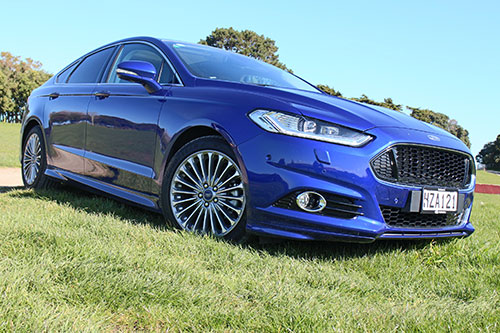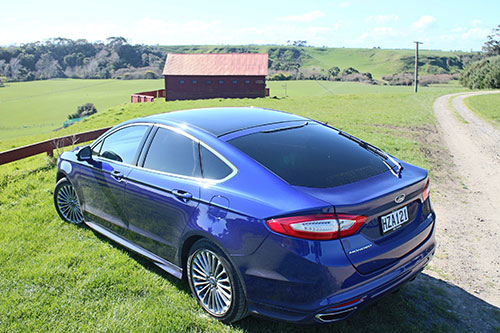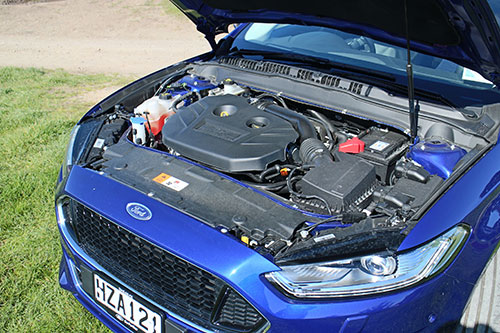Tuesday November 24, 2015
 By Richard Bosselman
By Richard Bosselman
For: Refinement, comfort, high technology.
Against: Interior quality lapses, soft handling, tech access challenges.
Score: 2.8/5
FIRST thing Ford New Zealand did when launching this car was to take a direct swipe at the Toyota Camry, which tends to lead this sector on the strength of its fleet presence.
Comparative advertising is always a tricky thing – the big risk is that the target brand might like to hit back with even more strength. Toyota didn’t do so, but Ford obviously became rattled enough by talk that it might that it subsequently explained that, while their campaign picked on Camry, it was really a throwdown to everything in the category. Mazda6, Hyundai Sonata, Kia Optima, Subaru Legacy, Holden Malibu, Skoda Octavia and Volkswagen Passat: They could also consider themselves on notice, too.
Back then, it seemed likely Ford was seeking to start a fight simply as way to get noticed and, more particularly, remind that the Mondeo was still in the hunt. After all, this new item arrived well after the one it replaced had departed. A long time between drinks.
Anyway, writing this at year-end, you have to wonder about the effectiveness of the strategy, given that Ford’s year-on-year passenger sales volume is down 14.5 percent, the biggest drop of any major player. And that’s in a year when the overall passenger car market seem set to reach 130,000 units, an all-time high. Yet the only Ford that is running strong at the time of writing is the Ranger which, being a ute – albeit as the country’s top-selling one - is classified as a commercial vehicle.
Given that the Mondeo in previous generations has always been something of asales stalwart, it might be surmised that this latest one is not pulling its weight. Which is a worrying sign, perhaps, given that it is charged with becoming Ford’s key family car once the Falcon goes in October 2016.
Mondeo retains historic familiarity in that it rolls in now in hatchback and wagon form, with the choice of a pair of 2.0-litre four-cylinder engines mated six-speed automatics (orthodox with the petrol here, a clutchless manual in the diesel).
It’s a car that took the long road to market. Our car is essentially the same car as the Ford Fusion that’s been available in North America since 2012; however the Mondeo side of things was delayed by, first, a engineering redesign then by a shift in production base from Belgium to Spain. The delay has been costly; back in 2013 Mondeo was the sector king, now Camry is dominant and Ford is having to start from the back of the pack.
Worse, at a time when Mondeo’s status could do with a lift, so could the medium car segment. It has also diminished, achieving five percent of new passenger car sales.
This appears to have tempered Ford’s sales strategy. There’s now less focus on the discount-driven fleet sector and more on those who are less likely to pin their decision-making simply on the deal they swing. Business users remain of interest, but the entry grade (previously LX, now Ambiente) that previously achieved most volume might be outsold now by the mid-spec Trend, perhaps even this flagship Titanium, which at $53,390 is more mid to upper management.

Styling, image:
The Fusion/Mondeo development is ‘One Ford’ in action, meaning a car endearingly European in previous form is more ‘transatlantic’ in approach now.
One-for-all translates intriguingly in terms of shape; overall it’s as before – the hatch is a bit less attractive than the wagon, in part through looking heavier around the haunches. It sits low enough to appear as though it’s perpetually carrying around a couple of bags of cement.
There’s some familiarity to the overall silhouette, though change is also evident with a rather larger grille. Detailing up close is classy and smart – the flagship’s LED daytime running lights, honeycomb intake and bodykit are all nice signatures. I’m less smitten by the overly complex design of those 17-inch alloy rims: Maybe Ford people don’t have to clean their own cars but these would be a bitch.
One other thought: For a design has been floating around for three years, it’s surprising that the Mondeo still looks modern. Tastes change so quickly these days that, by all rights, it shouldn’t. Yet it struggles to look special.
Same on the inside? Ford ergonomic qualities ebb and flow and there’s always a sense that, though the materials they choose are always tidy and decently robust, Mondeos are ultimately decked out more for the fleet use they largely fall into in Europe, rather than for private buyers here.
Not a lot of progress has been made in that area. Even though Ford have tried hard for a premium feel here, for instance using a lot of piano-lacquer trim and angled pieces of brightwork to provide an element of sophistication, some of the materials used elsewhere (the glovebox lid, door pockets and the slab of dark plastic slap-bang in the middle of the centre console, for example) really let the side down. Comparing with the new Passat – a natural rival at home – shows where Ford gets it right, and where it goes wrong: The VWm even in base form, is simply straight-out swankier. It probably doesn’t help that our well-driven test car had some annoying trim rattles and a squeaking sunroof.
Despite featuring roughly the same dimensions as the car it replaces, it looks large, and thankfully that spaciousness carries across to a cabin that, due to the glass roof’s opaque cover that lets in good natural light without risk of occupants being fried, feels airy. Storage space is commendable, with a load of room freed up in the front with the fitment of an electric handbrake, and the hatch design translates into a long, flat luggage space because the rear seats flod virtually flat. The slope of the tailgate ultimately compromises the height of the load and there’s a rather meaty load lip to negotiate. Always nice to see a full-sized spare under the floor, though.
Mondeo is packed with technology, a key ingredient – but unfortunately not wholly an attraction (I’ll come back to this) - being the Sync 2 touch-screen and voice-control system, but Titanium of course goes the extra mile, becoming a safety showcase. It has a suite of active driver aids, including adaptive cruise control, autonomous braking and self-parking. There are airbags galore, including something quite unique: inflatable seatbelt airbags on the outer-rear seats.
Also here are dual-zone climate control, digital radio, leather throughout with heated front and rear seats, LED tail-lights and keyless entry.
Powertrain, performance:
Titanium here doesn’t follow overseas’ convention and adopt the Mondeo’s best engine, the new diesel. Instead we have a 2.0-litre turbo-petrol that is known and respected as a good performer in multiple other Ford models including the Falcon. With maximum power of 177kW and top torque of 345Nm, presented from 2300-4900rpm, it is a strong and willing accomplice, with good mid-range torque and reasonable economy, Ford claiming an optimim 8.5 litres per 100km but the test car returning around 9.4. yet it doesn’t ever feel as brisk as the impressive power optimum suggests.
You sense that what restricts the engine from being more interesting is that it matches with a conventional six-speed automatic transmission rather than the automated dual-clutch PowerShift gearbox. That seems a shame; there’s good reason for going Powershift with the diesel – it copes better with the beefy torque loadings – yet it does mean that the transmission that offers the greater degree of driver involvement is with the engine that has capacity to deliver less.
As is, the Titanium runs smoothly and with good refinement at open road pace but feels a little tardy at low pace and when accelerating out of a dead stop. How much of that is due to the drivetrain and how much to the Mondeo’s pretty hefty kerb weight of 1700-odd kilograms is unclear, but it’s not what you’d call a sporty car by any means.
Driving appeal:
Well, the above comment really has spoiled any surprise. The past two Mondeos have been for enthusiasts. We’re told this version is very different from the US version in steering and suspension, yet while much of that famous dynamic sharpness retains, you do have to dig deep to unearth the fun factor. There’s less apparent litheness and little initial spark.
If anything, the sense that it has settled into a kind of comfort zone is enhanced by the car’s quietness. The cabin is a very pleasant place to spend a few hours driving; noise intrusion is low and it has a hushed ride.
The other side of this coin is that it feels really sanitised. Mondeos used to be about real driver engagement. This one just isn’t. One issue is the feel from its electrically controlled steering; there basically isn’t a lot going on under the fingers. It also feels like a big car on the road and pushing into tight bends and corners reveals the heft. Brake feel is good.
I love electronic assists and don’t have any fear of using them. But Titanium is almost undone by having too much technology. For instance, there’s the issue with the three-stage adaptive dampers. I can tell you now that these are not worth bothering with; it is too soft and unresponsive in the Comfort setting, while Sport mode offers a sharp, brittle ride that is exacerbated by the top-spec 18-inch rims and low-profile Continental tyres.
You might not discover this for yourself; while there’s loads of adjustability and personalisation available in the Mondeo, a lot of it is buried away under layers of sub-menus in odd places and the process required to even work out how to select these options can be way too complex.
The logic is to first try the main SYNC2 screen, which has a welcoming colour interface, including live Windows-style tiles on the home screen that give you simultaneous information from four different functions. But the answer to the suspension function is not here.
For that you need to go into an entirely different menu, on the main instrument console, operated by a couple of buttons at the tip of the indicator wand. These get you through two menus before you strike gold. That’s just way too complex.
But, then, so is SYNC2: I was a real fan when I first tried this in a lab in Detroit, but have now discovered there’s a whole world of difference between working through a voice-activated set-up with an expert at your side in an inert car and trying it yourself while driving.

Like the majority of voice systems out there, it’s just not up to the task of taking over even basic functionality. Its instruction requirements to even change a radio station are so frustrating. There’s another way of doing things, and that’s to revert to the touchscreen. But that’s almost as challenging: It all seems a bit too like texting while driving and you know how that’s frowned upon.
I appreciate that Ford is seeking to find a better way forward. I certainly agree that what they have now is, in a design sense, better than that awful Nokia-phone-from-2001 cluster of controls that used to feature in Fords. But as neutral as clean as the touchscreen looks – and as promising as a voice-prompted set up sounds - it’s still not the answer.
How it compares:
The Mondeo is stylish, offers superb refinement, is comfortable and those who work their way through the complexities of its set-up will find a lot of helpful technology; there’s a ton of it for the money.
However, there’s a sense that it struggles to impart the X-factor one craves when driving a brand new model; it just hasn’t the pizzazz of its predecessor or, for that matter, other European-spec Fords offered here. On top of that, cars like this are simply falling from vogue here. You get the sense that, if Ford could conjure a crossover equivalent with the sale level for the same kind of cash, that’s where people would be putting their money.

